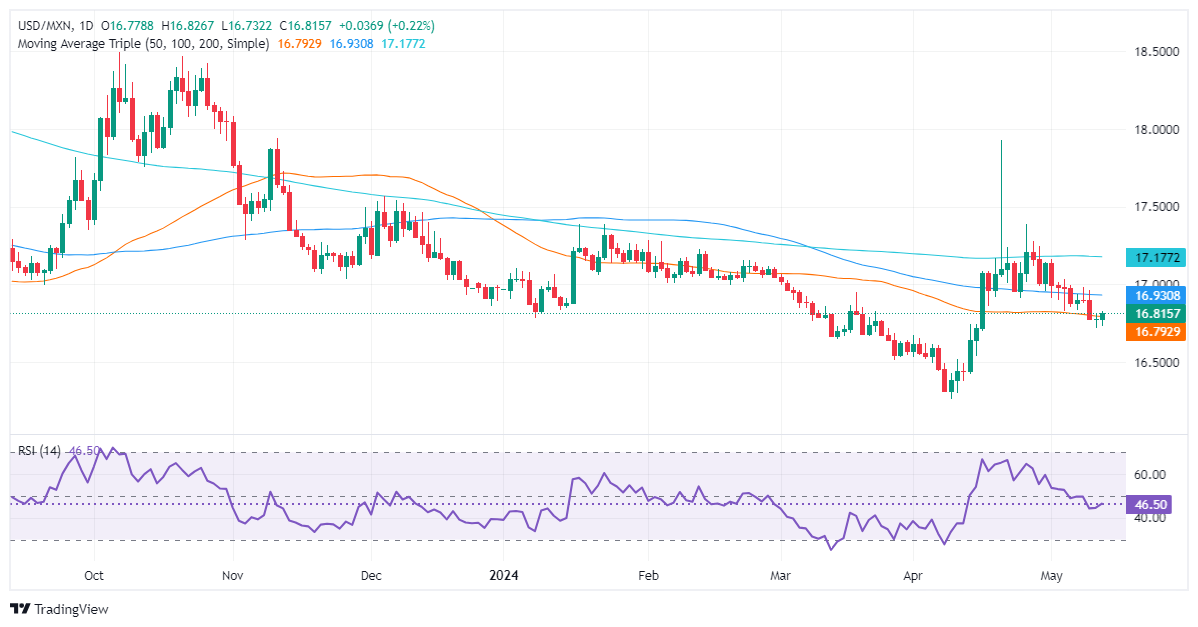- The Mexican Peso falls 0.51% against the Dollar after the governor of Banxico suggested possible rate cuts.
- Governor Rodríguez Ceja points to the downward trend in core inflation, fueling speculation about a rate cut on June 27.
- The focus is on US inflation data, critical for the Fed's upcoming monetary policy decisions.
The Mexican peso depreciated against the US dollar during the North American session on Monday, after the governor of the Bank of Mexico (Banxico), Victoria Rodríguez Ceja, commented: “We could evaluate downward adjustments” in the main reference rate. Meanwhile, traders are preparing for the publication of the latest inflation figures in the United States (US), which would be the center of attention as the Federal Reserve (Fed) outlines its monetary policy path. The USD/MXN pair is trading at 16.81, up 0.51%.
The governor of Banxico, Victoria Rodríguez Ceja, pointed out that the increase in general inflation was due to the volatility of non-core components. However, she added that underlying prices continued on a “very clear” downward trend. She added that, depending on the evolution of inflationary prospects, the Mexican central bank could evaluate whether to continue lowering interest rates, starting at the next meeting on June 27.
Last week, Banxico decided to keep rates unchanged at 11.00%, following the first rate cut in March. In its monetary policy statement, the Governing Council mentioned that inflationary shocks are expected to “take longer to dissipate”, prompting an upward revision of inflation figures.
On the other side of the border, the US economic agenda featured a speech by Fed Vice President Philip Jefferson, who stated that it is advisable to maintain restrictive official interest rates until inflation subsides.
Daily summary of market movements: The Mexican peso falls amid an empty economic agenda
- Mexico's economic agenda will be absent during the current week. The next economic data to be released will be retail sales on May 20, followed by Gross Domestic Product (GDP) and inflation figures on May 23.
- Banxico will reveal its latest meeting minutes on May 23.
- April data shows that Mexico's overall inflation is slowing. However, underlying prices are falling. This has led Banxico to revise its inflation forecasts, with the bank expected to reach its 3% target towards the last quarter of 2025, later than March estimates for the second quarter of 2025. Inflation is expected to underlying will reach 3% in the second quarter of 2025.
- In the short term, the Producer Price Index (PPI) will be published on the US economic agenda on May 14, followed by the Consumer Price Index (CPI) and retail sales on May 15.
- USD/MXN traders are keeping an eye on Fed Chairman Jerome Powell's statement on May 14.
- The deterioration in consumer confidence, along with the cooling of the labor market, has opened the door for investors to consider rate cuts by the Fed. This is because policymakers at the US central bank recognized that the risks to achieving its dual mandate on employment and inflation “moved toward a better balance over the past year.”
- Futures market data shows the odds of a quarter-point Fed rate cut in September stand at 79%, up from 78% last Friday.
Technical analysis: The Mexican Peso falls while the USD/MXN exceeds 16.80
The USD/MXN bearish trend remains in place, but a daily close above last Friday's high at 16.81 could form a bullish engulfing candle pattern, which could pave the way for a bullish leg. In the short term, momentum favors sellers as the RSI remains bearish but is quickly turning bullish.
If buyers lift the exchange rate above the 100-day SMA at 16.92, a rally towards the psychological level of 17.00 could be exacerbated. A break of this last level would expose sellers to a decline. Breaking this last level would expose the 200-day SMA at 17.17, followed by the January 23 high at 17.38 and the year-to-date high at 17.92.
On the other hand, a bearish continuation could resume if USD/MXN falls below the 50-day SMA at 16.78, opening the door to test the 2023 low at 16.62, followed by the current year-to-date low of 16.25 .

Frequently Asked Questions about the Mexican Peso
What is MXN?
The Mexican Peso is the legal tender of Mexico. The MXN is the most traded currency in Latin America and the third most traded on the American continent. The Mexican Peso is the first currency in the world to use the $ sign, prior to the later use of the Dollar. The Mexican Peso or MXN is divided into 100 cents.
What is Banxico and how does it influence the MXN?
Banxico is the Bank of Mexico, the country's central bank. Created in 1925, it provides the national currency, the MXN, and its priority objective is to preserve its value over time. In addition, the Bank of Mexico manages the country's international reserves, acts as a lender of last resort to the banks and advises the government economically and financially. Banxico uses the tools and techniques of monetary policy to meet its objective.
How does inflation impact the MXN?
When inflation is high, the value of the Mexican Peso (MXN) tends to decrease. This implies an increase in the cost of living for Mexicans that affects their ability to invest and save. At a general level, inflation affects the Mexican economy because Mexico imports a significant amount of final consumption products, such as gas, fuel, food, clothing, etc., and a large amount of production inputs. On the other hand, the higher the inflation and debt, the less attractive the country is for investors.
How does the Dollar influence the Mexican Peso (MXN)?
The exchange rate between the USD and the MXN affects imports and exports between the United States and Mexico, and may affect demand and trade flows. The price of the Dollar against the Mexican Peso is affected by factors such as monetary policy, interest rates, the consumer price index, economic growth and some geopolitical decisions.
How does the Fed's monetary policy affect Mexico?
The exchange rate between the USD and the MXN affects imports and exports between the United States and Mexico, and may affect demand and trade flows. The price of the Dollar against the Mexican Peso is affected by factors such as monetary policy, interest rates, the consumer price index, economic growth and some geopolitical decisions.
Source: Fx Street
I am Joshua Winder, a senior-level journalist and editor at World Stock Market. I specialize in covering news related to the stock market and economic trends. With more than 8 years of experience in this field, I have become an expert in financial reporting.







